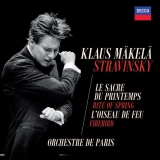Sehr transparent, orchestral perfekt ausgefeilt und klanglich ausgewogen: die neue Einspielung des Sacre du Printemps mit dem Orchestre de Paris unter seinem Chefdirigenten Klaus Mäkelä ist zweifellos von guter Qualität. Aber sie bleibt bloß im Spitzenfeld, ohne an dessen Spitze zu gelangen. Im ersten Teil fehlt es an Spontaneität, an unmittelbar packendem Feuer. So richtig mitreißend wird die Interpretation in der Danse de la Terre. Schön sensuelle Passagen gibt es im zweiten Teil, vor allem in den Cercles mystérieux des adolescentes, aber auch sonst gefällt mit der zweite Teil des Balletts besser, weil Mäkelä spannungsvoller dirigiert, leider nicht durchgehend.
Im Feuervogel kommen Mäkeläs Klangvorstellungen besser zur Geltung. Wie das vor vielen Jahren Leonard Bernstein und dem Israel Philharmonic und rezent auch Gustavo Gimeno mit dem Philharmonischen Orchester Luxemburg gelang, kostet auch Mäkelä die Musik ganz wunderbar aus, und der Hörer hat den Eindruck, musikalisch entführt zu werden in die Welt des Feuervogels, gepackt von der schieren Magie der Musik, in der Figuren, Blumen, ja Welten sichtbar werden. Diese Aufnahme, die von einer sehr hohen Auflösung des Klangbildes profitiert, ist einfach herrlich. Mäkelä beleuchtet das Werk mit ebenso viel Spannung wie Geschmeidigkeit. Die Raffinesse der Artikulation, die Intelligenz der Atmung, die subtilen Abstufungen und die Aufmerksamkeit für das kleinste Detail sind absolut fantastisch.
Very transparent, orchestrally perfectly polished and balanced: the new recording of Sacre du Printemps with the Orchestre de Paris under its chief conductor Klaus Mäkelä is undoubtedly of good quality. But it remains merely in the top field without reaching its top. In the first part there is a lack of spontaneity, of immediately gripping fire. The interpretation becomes really rousing in the Danse de la Terre. There are beautifully sensual passages in the second part, especially in the Cercles mystérieux des adolescentes, but I also like the second part of the ballet better because Mäkelä conducts with more tension, unfortunately not throughout.
In the Firebird, Mäkelä’s sonorities work better. As Leonard Bernstein and the Israel Philharmonic did many years ago, and more recently Gustavo Gimeno with the Luxembourg Philharmonic, Mäkelä savors the music beautifully, and the listener has the impression of being taken musically into the world of the Firebird, gripped by the sheer magic of the music in which figures, flowers, even worlds become visible. This recording, which benefits from a very high resolution of the sound image, is simply glorious. Mäkelä illuminates the work with as much excitement as suppleness. The sophistication of the articulation, the intelligence of the breathing, the subtle gradations, and the attention to the smallest detail are absolutely fantastic.
























